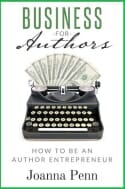By Joanna Penn (@thecreativepenn)
Who can write thrilling novels, useful nonfiction for authors, run one of the most popular indie writing and publishing blogs, and make media and live appearances all at the same time? Why, Joanna Penn can. I’m a big fan of Joanna’s personal and practical approach to indie publishing, and it’s been a real thrill to watch her become more and more popular over the years. Read this article and you’ll see why I said this about her new book, Business for Authors: How to Be an Author Entrepreneur, which is just out:
“The best book I know of for authors who are serious about making their writing into more than a hobby. Joanna Penn writes in an engaging, personal style to lead you through the often-confusing world of publishing for profit, sharing her own hard-won lessons. A boon to self-publishers everywhere.”
As the self-published author of a dozen books, Joanna knows what it takes to keep publishing year after year. Here’s her article on creating a production plan for your own books, and why you might want to do it. Enjoy.
Your Muse wants you to write. She wants you to take the ideas that spark in your mind and turn them into finished works that inspire, entertain and educate. She wants you to change people’s lives and that’s exciting!
Perhaps you have lists of ideas in journals, or a document where you keep thoughts that could be seeds of new projects. Maybe you have a scrapbook or a virtual pin board where your semi formed ideas bounce around, waiting for you to pick them next.
So how can you turn those ideas into books? How can you organise them so you can actually get writing?
In my previous corporate life, I walked the floors of production plants alongside whizzy robots and machines making things. The term ‘production plan’ fills my mind with questions about raw materials and how to work back from shipping dates to when each product needs to be made. That’s one extreme, but many professional authors are now creating production plans for their own writing business, because you can’t exploit the rights for your books unless you have those books ready to go!
If writing is your business, and you want to take it to the next level, your production plan will keep you accountable to your Muse, and ensure you satisfy your readers on a regular basis. It will also corral your ideas into something more manageable so you can see what’s coming. When I talk to the really successful indie authors, the big earners, they all have production plans, which is why I now have one, too!
What is a production plan?
It doesn’t need to be anything too flash, just a one-pager with the next 12 months or more and which projects you’ll work on and when. You could use a spreadsheet or just a Word document. Don’t let the structure stop you! It doesn’t need to be complicated, just useful.
I have a two-page document broken down into months and what should be happening per month. For example, in the month I am writing this, it says:
- Start first draft Inquisition, a full-length ARKANE thriller
- Publish ebook, print and audiobook of Business for Authors
- Publish Profanazione print edition in Italian
- Publish audiobook of Day of the Vikings
I have similar one-liners per project that go out in a rolling 12 month period, plus some notes at the end for ideas for other books. I can see what I should be working on every month and I can give my editor and cover designer notice on when things will be ready. I can see what my marketing focus should be per month. And of course, my Muse knows that I will be getting to those other ideas on the list and I am accountable for how I spend my time.
You might think this is too simple, but even just thinking ahead a few months will help with your creative productivity and enable a longer-term focus for your author business.
Factors to consider in your production plan
- How many books do you want or need to write this year? This will depend on your business model and how your cash flow works, as well as your speed and confidence in writing. Be realistic but also try to stretch yourself. By definition, plans are changed over time, but it’s good to have a target to begin with.
- How long does it take you to write each type of book? For example, it takes me six to nine months to get a new full-length fiction book out in an established series at the moment, two to three months for a novella, and around four months for a non-fiction book. I also like to ‘rest’ my manuscript after first draft so that I forget it before editing and this adds at least a month to the schedule. Using these timelines, I can work out when I will be moving onto the next project and when I need to focus.
- When do you need extra time in your plan? For example, when are your kids on school holidays? Or when are you away? We all have these life rhythms and there’s no point in stressing if you can’t deliver on time. Yes, push yourself and stay accountable, but also, we write to live, so make room for the other things that are important for you in your plan.
- How much advance notice do you need to give your editor and cover designer? Put approximate dates in the diary so they know they can expect to receive work then. This accountability also helps you to deliver on time.
 You should now be able to come up with a production plan, even if it is only basic. There are no rules, so start with a short list of projects and rough dates and make it more detailed over time. Have fun!
You should now be able to come up with a production plan, even if it is only basic. There are no rules, so start with a short list of projects and rough dates and make it more detailed over time. Have fun!
Joanna’s new book, Business for Authors: How to be an Author Entrepreneur,’ is out now in ebook, print and audio.
 Joanna Penn is an author, speaker and entrepreneur, voted as one of the Guardian UK Top 100 creative professionals 2013. Her website, TheCreativePenn.com is regularly voted one of the top sites for authors and self-publishers. Writing as J.F.Penn, Joanna is also a New York Times and USA Today bestselling thriller author. Connect on Twitter @thecreativepenn.
Joanna Penn is an author, speaker and entrepreneur, voted as one of the Guardian UK Top 100 creative professionals 2013. Her website, TheCreativePenn.com is regularly voted one of the top sites for authors and self-publishers. Writing as J.F.Penn, Joanna is also a New York Times and USA Today bestselling thriller author. Connect on Twitter @thecreativepenn.
Photo: bigstockphoto.com


